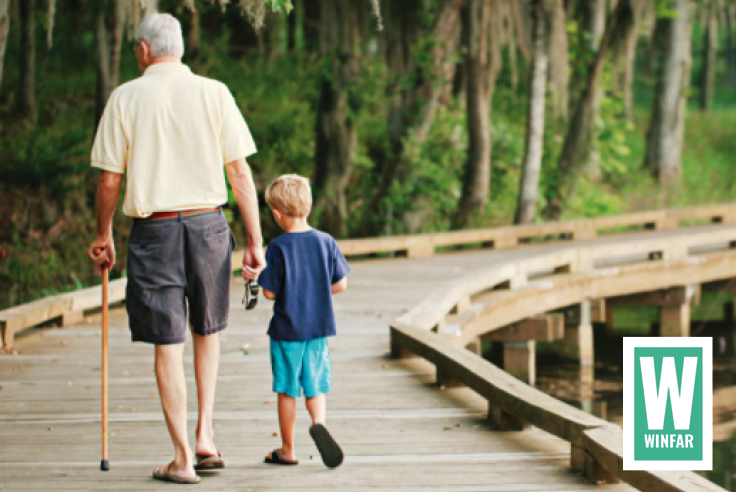How to Use a Cane Correctly
Canes are valuable assistive devices that can, IF used correctly, help you walk safely, improve your balance, give support, and reduce your risk of falling.
But, believe it or not, using a cane correctly is not as instinctive, or as simple as you would think.
It takes a little practice. Learning how to use it properly is essential to preventing falls.
After choosing the cane that matches your needs, it’s important to learn how to use it correctly.
It’s a little more tricky than most people expect.
Three important rules for using a cane correctly
There are 3 important rules you need to know and apply when using a walking stick:
- Always hold the stick in the hand opposite the weaker side.
- Position the cane tip next to your stronger leg, on the opposite side to your injured/weaker leg.
Using a walking stick in this way allows you to maintain stability when walking and relieves stress and discomfort from your injured side. - When walking, move the cane forward together with the weaker leg, as a support
- ALWAYS start your journey with your good leg. It’s important that your first full-weight bearing step is on your strong leg, and supported, before taking a step with your “bad” leg.
How to use a cane correctly: 4 simple steps
This is a topic that might be best explained in a video:
Let’s unpack the steps:
- Always hold the cane in the hand on your “good” side (opposite the injury).
- Position the cane slightly to the side and about 2 inches forward.
- Take your first step with your good leg. Then your second with your “bad” leg and bring the cane forward at the same time
- The cane and opposite leg should touch the ground at the same time.
- Repeat
Common mistakes
- Make sure your cane is the right height to support you. Your elbow should always remain bent at 20 to 30 degrees.
- Hold the cane in the hand on your “good” side (opposite the injury).
- Keep the cane close to you as you move
- Take your time, and if necessary, take smaller steps
Note: It is important to take your time when first starting out. And don’t be embarrassed to ask someone to walk alongside you and support you, at least till you get the hang of it, and feel comfortable and confident walking alone, with your cane. It takes a little practice, so don’t rush. Rushing only causes you to lose concentration, and coordination and make mistakes.
Make sure you feel fully confident before you venture out on your own.
And remember to keep your eyes forward, and straight ahead. Not down at your feet.
Navigating Stairs
Stairs can be particularly tricky if you are new to using a cane. A staircase with a handrail, is first prize, but not all staircases have handrails, so proper technique and a little patience will help you get safely up and down stairs no matter the situation.
When walking upstairs with a cane:
- Hold to the rail, if available, and hold the cane in the other hand
- Start with your cane and both feet on the same step.
- Climb up the stairs by following the rule “up with the good”.
Hold the cane firmly for balance, then lift your strong leg to the next step. - Bring the cane and your weaker leg up to meet the stronger leg.
- Repeat until you reach the top of the stairs.
When walking downstairs with a cane:
- When going down the stairs, hold the rail in one hand and the cane in the other
- Now it is “down with the bad” first. So holding the cane firmly for balance, step down with your weaker leg to the next step.
- Then bring your strong leg down to the same step as the weaker leg. The weaker leg and the cane step down first then the stronger leg steps down meet them.
- Repeat until you reach the bottom of the stairs.
DISCLAIMER: This website does not provide medical advice. This information, including text, graphics, images, and other material contained on this website is for information purposes only. No material on this site is intended to be a substitute for professional medical advice, diagnosis, or treatment. Always seek the advice of your physician or other qualified health care provider with any questions you may have regarding a medical condition or treatment before undertaking a new health regime, and never disregard professional medical advice or delay in seeking it because of something you have read on this website.
Sources:
https://www.healthline.com/health/how-to-walk-with-a-cane
https://seniorsflourish.com/canethecorrectway/
https://www.easeliving.com/blogs/news/how-to-walk-with-a-cane
https://www.bluebadgecompany.co.uk/pages/walking-stick-guide
https://www.verywellhealth.com/walking-with-a-cane-2696294
https://mobilitydeck.com/how-to-use-a-cane-properly/
https://www.snugsafe.com/all-posts/how-to-use-a-cane
https://my.clevelandclinic.org/health/articles/15541-how-to-use-a-cane

